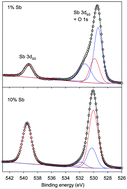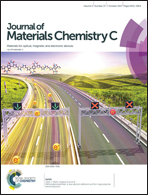Electronic properties of antimony-doped anatase TiO2 thin films prepared by aerosol assisted chemical vapour deposition
Abstract
The electronic properties of antimony-doped anatase (TiO2) thin films deposited via aerosol assisted chemical vapour deposition were investigated by a range of spectroscopic techniques. The incorporation of Sb(V) into the TiO2 lattice was characterised by X-ray absorption spectroscopy and resulted in n-type conductivity, with a decrease in sheet resistance by four-orders of magnitude compared to that of undoped TiO2 films. The films with the best electrical properties displayed charge carrier concentrations of ca. 1 × 1020 cm−3 and a specific resistivity as low as 6 × 10−2 Ω cm. Doping also resulted in an orange colouration of the films that became progressively stronger with increasing Sb content. X-ray photoelectron spectroscopy showed that substantial segregation of Sb(III) to the surface of the film was associated with the appearance of lone pair surface states lying above the top of the main O 2p valence band. The pronounced visible region absorption in the films is attributed to transitions from the Sb(III) states at surface and grain boundary interfaces into the conduction band. The segregation of Sb leads to p-type surface layers at high doping levels and limits the mobility in this new conducting oxide.



 Please wait while we load your content...
Please wait while we load your content...